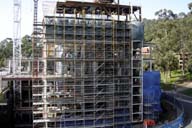
|
Image-CR0369
An overview of Stanley Hall construction in early 2005, a 290,000 sq. ft. bioengineering and biotechnology laboratory consisting of seven levels of steel framing over a three level concrete basement with a seismic lateral force resisting system of buckling restrained braces in the upper levels and concrete shear walls at the basement levels. The design parameters aim at resuming occupancy within a few weeks following a rare, large earthquake. The building is less than 50m from the Hayward Fault.
|
|
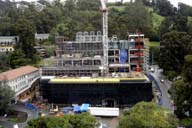
|
Image-CR0370
Overview of the Stanley Hall construction in early 2005. Buckling restrained braces were chosen for as the seismic lateral force-resisting system for the upper floors of the steel framed building because of their large ductility, energy dissipation capability, and relative ease of repair after a major earthquake
|
|
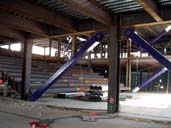
|
Image-CR0372
View of interior steel framing of Stanley Hall bioengineering facility with buckling restrained unbonded braces connected to framing at gusset plates.
|
|
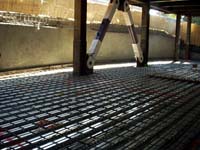
|
Image-CR0374
View of seismic lateral force resisting system known as buckling-restrained unbonded braces illustrating eccentric configuration and large gusset plate connections to steel framing
|
|
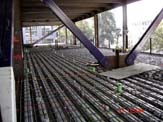
|
Image-CR0371
View of pinned connections and gusset plates for the buckling restrained unbonded braces in the new Stanley Hall bioengineering facility. In general, buckling restrained braces consist of steel core brace members covered with unbonded (soft, rubber-like) material and an outside restrainer (normally a steel tube filled with mortar or concrete). The core member buckles laterally but its deformation is restrained resulting in stable hysteretic load-deformation characteristics.
|
|

|
Image-CR0373
Stanley Hall bioengineering and biotechnology laboratory building construction sign
|
|

|
Text-13WC001681
Mahin, Stephen A.; Uriz, Patxi; Aiken, Ian D.; Field, Caroline; Ko, Eric; Seismic performance of buckling restrained braced frame systems
|
|









